Michigan vegetable crop report - May 24, 2022
Warm-season crops are taking off, asparagus harvest is strong.

Weather
Watch Jeff Andresen’s weather update here.
Last week saw a cool start with a warm Friday, with most areas picking up 0.5-1” of precipitation (with the exception of some West Central Counties). Degree-day accumulations are several days ahead of normal for most of the state, with the exception of the western Upper Peninsula.
The forecast calls for:
- Cloudy and windy weather with rain spreading West to East by Wednesday afternoon and continuing overnight through Thursday.
- Variably cloudy skies with scattered showers possible Friday and Saturday.
- Daytime temps mostly in the 60s and 70s through Friday with lows in the 40s and 50s.
- Warmer temps Sunday and early next week with scattered showers possible.
- Precipitation is forecast to total 0.75-1.25” over the coming week.
- Medium range guidance calls for warmer- and wetter-than-normal weather next week.
- The new seasonal outlook for June-August calls for above-normal temperatures.
Help is here: Get plugged into the new Enviroweather
Do you need help with setting up an account and dashboard on Enviroweather’s new website? You can send an email to eweather@msu.edu with the weather stations, crops and models that you are interested in, and we’ll set it up.
A weed to watch
Purple amaranth was first detected in Michigan in 2019. This year, we have been noticing it in more places, including in field production but also in greenhouses. In some initial screening back in 2019, one population showed resistance to herbicides such as Lorox and Caparol but others were still susceptible. It has a distinct notched leaf-tip.
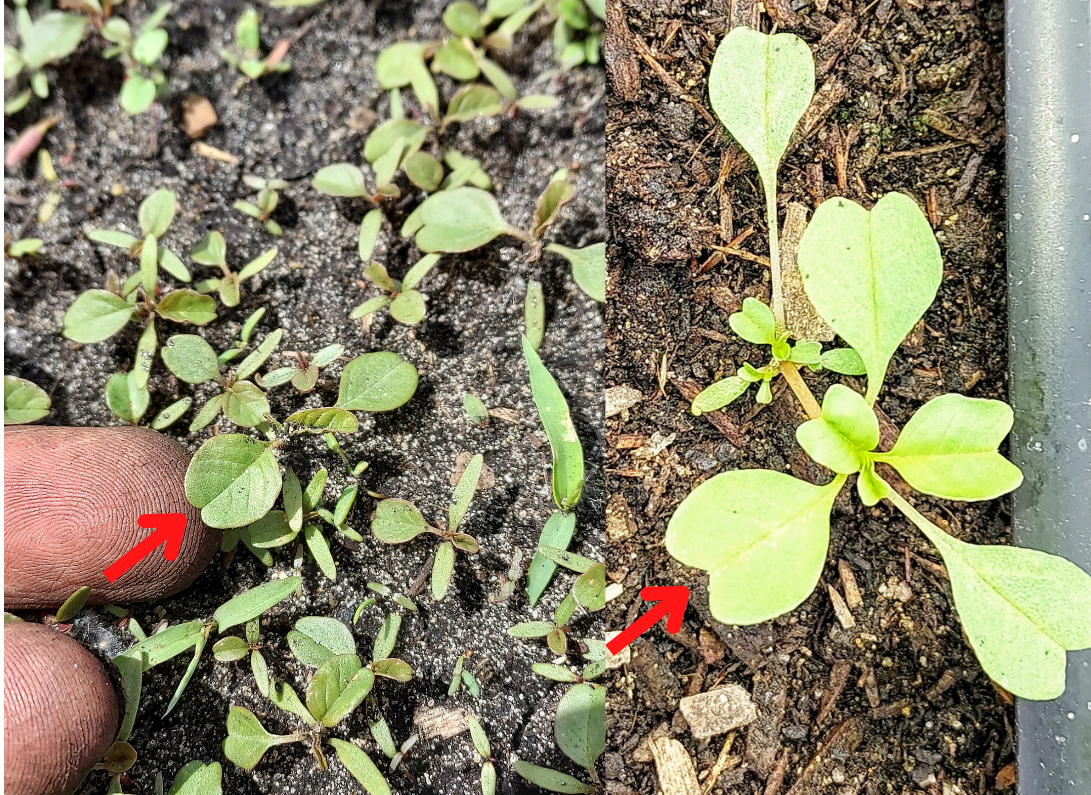
Crop updates
Asparagus
West Central growers had lug-busting pickings over the weekend. This week's cooler weather has helped slow things down. We are likely through the biggest pickings, though there is plenty of asparagus to come.
Shutdown of young fields has started in Oceana County. Consider covering young plantings with chlorothalonil or mancozeb once they branch and begin to fern out. Tebuconazole can be included if rust is a concern.
Herbicides-or lack of them-is on grower minds as international supply chains continue to be a challenge. As shutdown nears, consider that Prowl H2O (a.i. pendimethalin) “holds back” a similar spectrum of weeds as Dual Magnum-crabgrass, pigweed and select broadleaves-with the addition of lambsquarters and possibly improved sandbur control. No more than 8.2 pints can be applied in a season. Another pre-herbicide with broadleaf activity can be included to broaden the spectrum of weeds suppressed.
On the post-emerge side of things, hormonal herbicides like clopyralid can be helpful partners with glyphosate for select problem perennials including Canada thistle, broadleaf dock, rush skeletonweed, and annuals like marestail. What are some alternatives to clopyralid?
- 2,4-D is a commonly used partner with glyphosate, available both as the well-known Formula 40 but also the less volatile 2,4-D choline formulation Embed Extra. It carries Canada thistle, marestail and the docks on the label as well as many annual broadleaves; for dock and thistle it includes a note that control may be improved with applications to small weeds and/or use of higher labeled rates.
- Quinclorac (e.g., Quinstar) can help suppress Canada thistle, though its superpower is field bindweed control.
- Dicamba carries many of these weeds on the label, but can also injure asparagus and carries the risk of volatilizing.
- One last note: Clopyralid timing is key for some perennials including Canada thistle (up to bud stage) and rush skeleton weed (best to target rosettes with clopyralid preharvest).
Minor purple spot was visible on some spears after our recent cooler weather. Keep an eye out for it after our upcoming wet weather. The risk of issues will be higher in fields that had severe purple spot in 2021, since this disease overwinters on dead fern. Risk is reduced in dry weather (less risk of spore discharge) and with warmer temps (less time for infection before harvest).
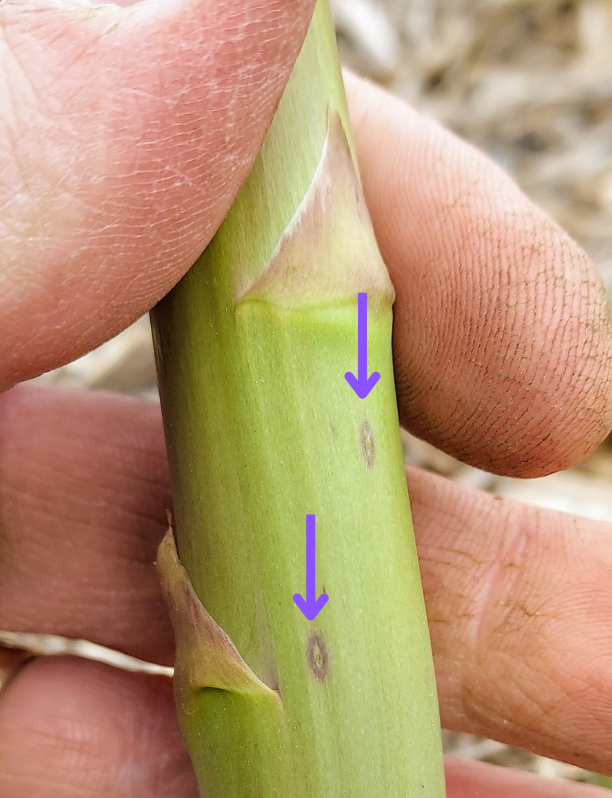
Carrots and celery
Planting of processing carrots is wrapping up this week in West Central ahead of the rain. To date scouts report low leafhopper activity in celery.
A quick note on crabgrass: partial resistance to clethodim was detected in one Oceana County population in carrots in 2021. This is just something to note, in case clethodim does not do what is expected. It’s unclear if this is a very localized or broader issue.
Cole crops
Swede midge has most likely emerged for the season, and growers with a history of this pest should protect crops with row covers for as long as possible, or treat with insecticides this week, and again in a week. Reducing the overwintered population is key to suppressing later generations and the buildup that occurs through the season. Immediate post-harvest crop destruction, and a clean break from cole crops and brassica weeds for at least half a season is the best way to crash swede midge populations.
The first peak of cabbage maggot egglaying should be slowing in the coming 1-2 weeks. Maggots had hatched and were tunneling in West Central Michigan. It is a good time to check crops to assess damage. Note, even when peak does pass there will still be flies active.
I had a nice conversation with growers visiting from the United Kingdom this week, who reportedly went through the “loss of Lorsban” a while back. These large-scale growers now use floating covers to exclude flies from laying eggs (just like small-scale growers do here). Now that they have it down, it has been a success. The high up front cost of the more durable covers they use can be spread over multiple seasons (reportedly 7-10), lessening the blow. MSU trials with grower collaborators also found floating row cover was better than any insecticide. It is something to consider as the industry discovers what works (and doesn’t) this transitional year. Of course, feasibility depends on returns to cover additional costs.
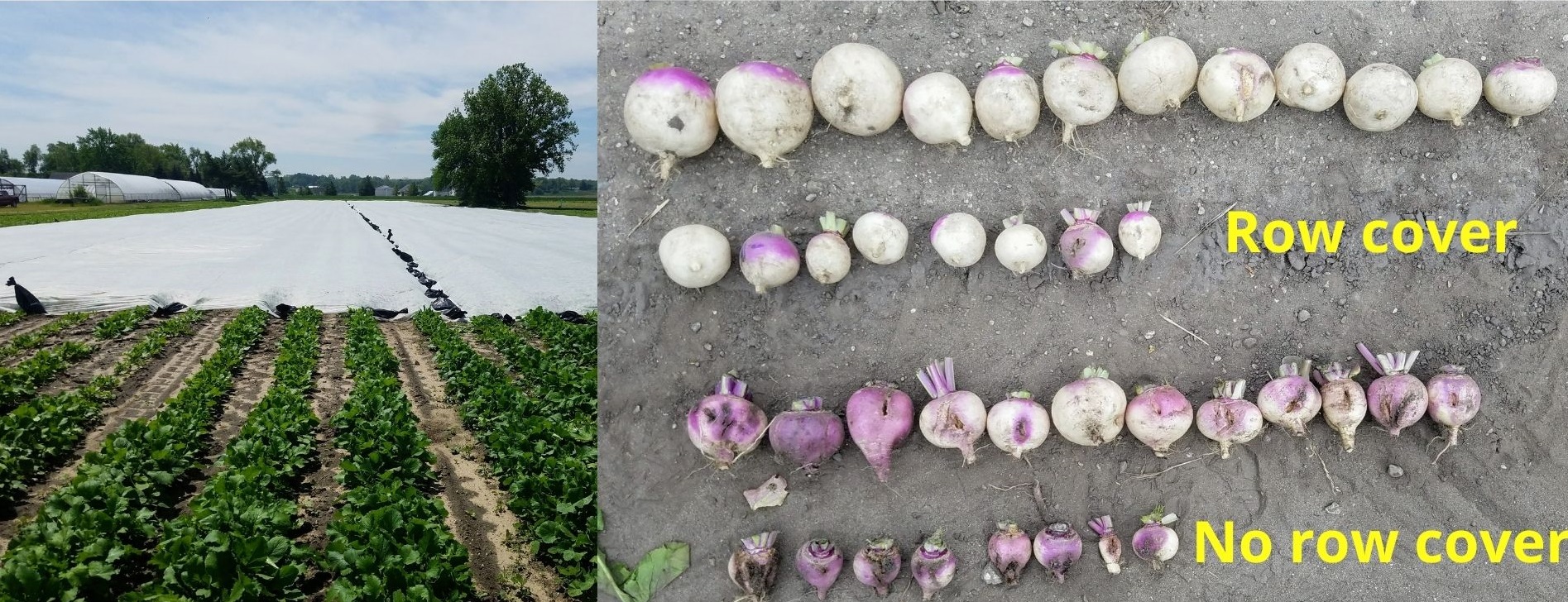
Cucurbits
Squash and slicing cucumbers were being seeded and transplanted this week in SW Michigan. Squash sowing was on tap in West Central. Pumpkins, hard squash, melons and watermelons are on the docket.
Onions/Garlic
More bulb onions, green bunching onions, and leeks were being transplanted this week. Garlic is around 12 inches tall.
Direct-sown onion growth stages remain very variable across the region, given wet and cold conditions. Stay tuned for an update on using PSNT (pre-sidedress Nitrogen testing) for making topdress decisions in onions. Past work by Dr. Hayden and Warncke has shown that-on muck soils-enough Nitrogen can be mineralized in warm weather to reduce or even eliminate the need for a topdress, without a yield penalty. It can be a way to make sure plants get what they need while providing possible savings where Mother Nature is already doing the work.
Peas/Beans
One Gratiot County grower reported that beans were up with their first true leaves this week and exhibiting some temporary herbicide injury. This is common and plants will grow out of it. Cool weather can increase the effects of preemergence herbicides on the crop.
Sweet corn
Sweet corn planting continues, and previous seedings have emerged. Baresoil corn planted in late April have 4 leaves, and some plasticulture corn was at 6 leaves in Genesee County this week. European Corn Borer degree day models suggest that their emergence and first flight are due this week. First generation corn borer is typically of less concern, but it can do some whorl feeding.
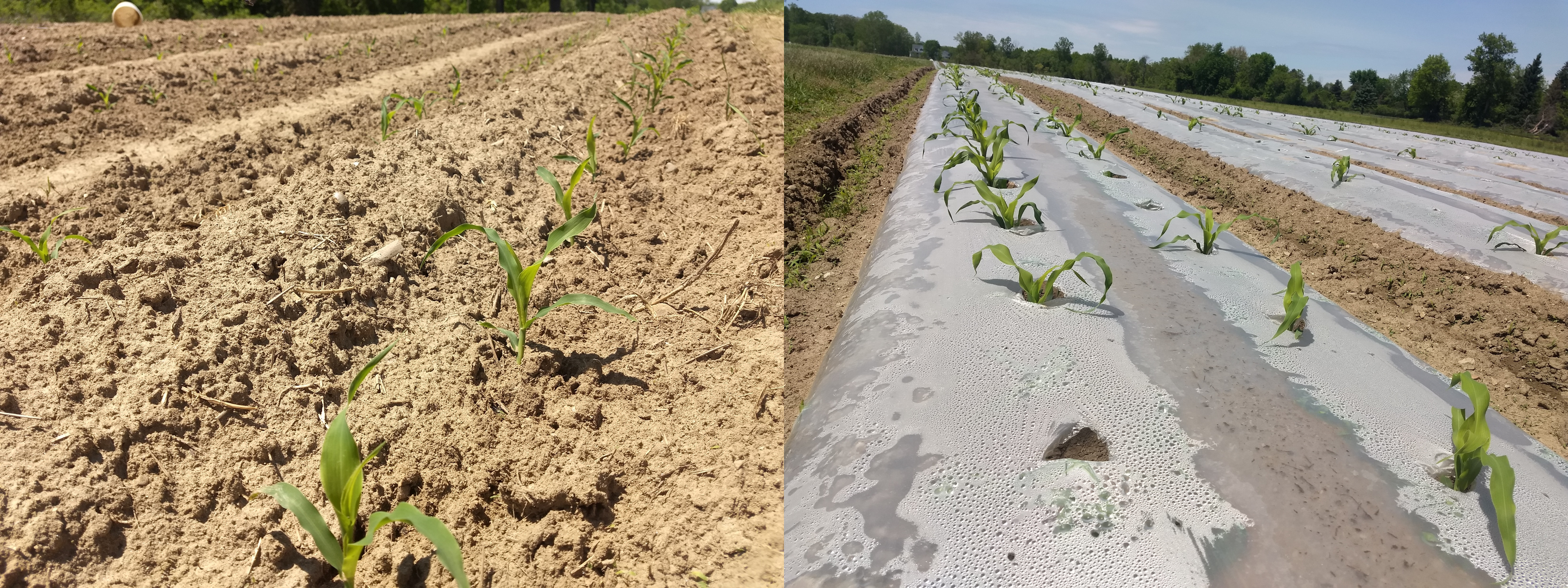
Strawberries
Strawberry bloom continues. Fruit are beginning to size. All the leaves are out by now, maintain fungicide coverage to protect the leaves and help prevent botrytis as fruit begin to show. With fruit beginning to form, western flower thrips populations should be monitored and appropriate insecticides used as needed.

Fruiting vegetables
Field plantings of tomatoes, peppers, and eggplants was underway this week across the state. Some growers utilize mixed-age plantings and low-tunnels to stagger harvests. When using low-tunnels, be vigilant about checking the weather for bright sunny days, and consider irrigating.
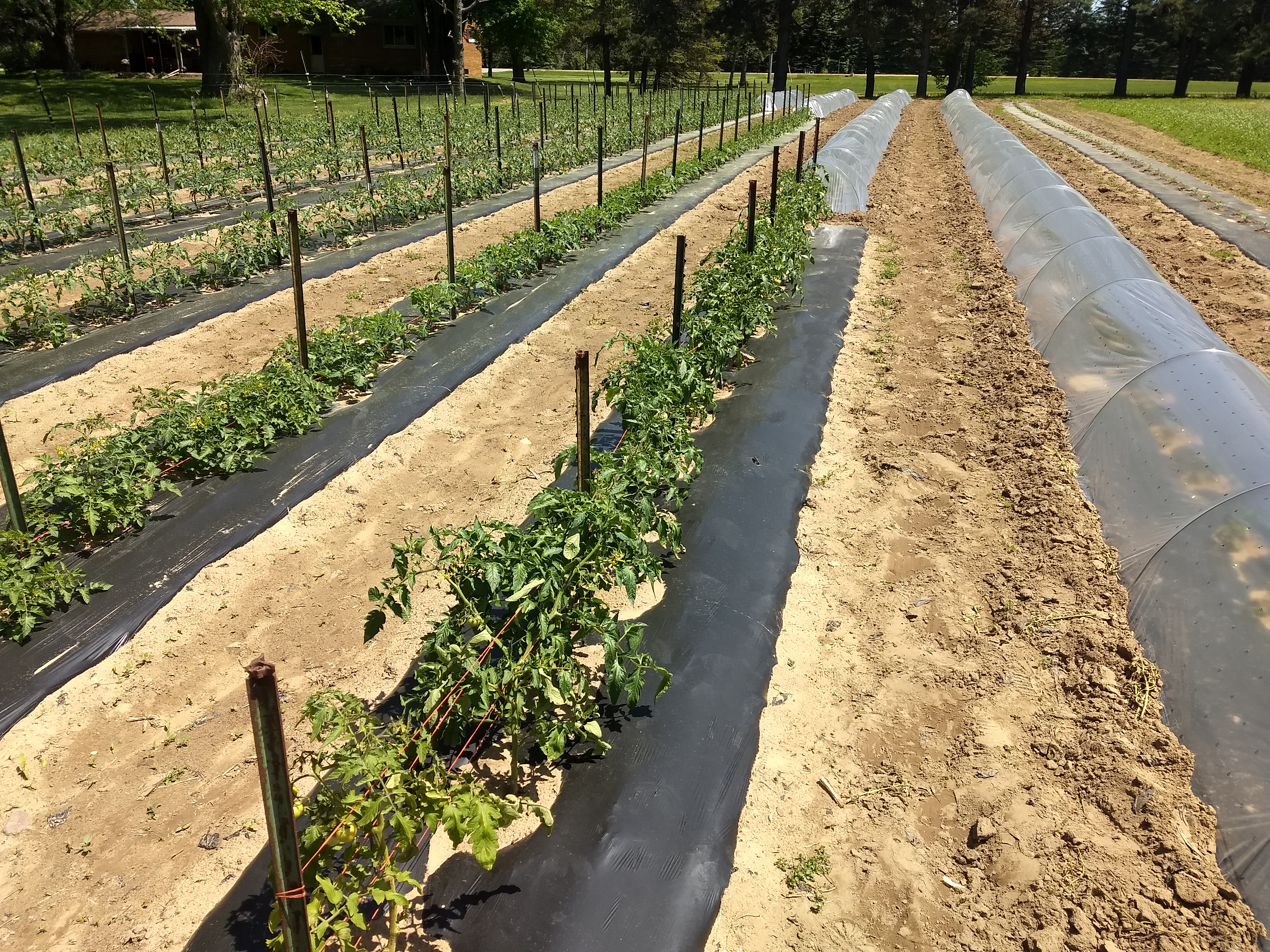
Events
-
May 25, 7-9 a.m. - Field Crops Virtual Breakfast: Dry bean planting with Scott Bales (RUPS available)
-
May 25, 12-1 p.m. - MSU Hop-Chat bi-weekly webinar
-
May 25, 1:30-2:30 p.m. - MSU Chestnut Chat bi-weekly webinar
This work is supported by the Crop Protection and Pest Management Program [grant no 2021-70006-35450] from the USDA National Institute of Food and Agriculture.



 Print
Print Email
Email




